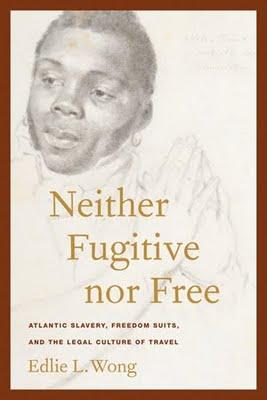Neither Fugitive nor Free: Atlantic Slavery, Freedom Suits, and the Legal Culture of Travel

In this superb book, Edlie Wong analyzes the territorialization of freedom and slavery in the antebellum Atlantic. While reading it, I frequently recalled Martin Luther King, Jr.’s warning that “injustice anywhere is a threat to justice everywhere.” Yet Wong’s work also suggests the converse is true: the existence of free blacks threatened institutionalized slavery on practical and moral grounds, while the continuation of legal slavery in any jurisdiction challenged core notions of freedom, including freedom of movement and travel. This conflict played out in courtrooms and the court of public opinion as slaves sued for legal emancipation—a strategy fraught with its own contradictions.
Wong considers not only American struggles, but also how freedom on European soil and slavery in the West Indies influenced and was influenced by American slavery. Slave narratives, novels, popular press, and legal documents are the material from which Wong makes a dialectical critique of pro- and anti-slavery thought as it crystallized around legal cases. As befits her topic, she organizes the book locally rather than chronologically.
Chapter one deals with nationalistic British abolitionism, which championed freedom while confining it within British borders. Chapter two moves across the Atlantic to northern American free states, which offered southern slaves traveling there a choice: sever social ties and gain individual freedom, or return to home and slavery. Chapter three focuses on the Dred Scott decision and examines legal emancipation in the southwest U.S. Chapter five and the concluding chapter again take a transatlantic standpoint. The former examines the criminalization and de facto enslavement of free blacks—both American and foreign-born—who traveled into southern slave states as sailors. The latter briefly treats the question of American citizenship after emancipation and travel abroad.
Throughout, Wong sharply analyzes the rhetoric of pro- and anti-slavery literature. Whites on both sides generally acceded to the “chattel principle” that slaves are an extension of their masters' wills. Thus, unlike fugitive slaves, American slaves brought by their masters onto free soil might sue for their freedom precisely because the masters had made the decision, effectively consenting to their emancipation. Paradoxically, the movement onto free soil instilled slaves—now to be considered free agents—with their own wills, and any who returned with their masters to slave territory were argued to have chosen re-enslavement. Slaveholders, thus, saw their slaves as will-less objects, at the same time considering their enslaved status was the slaves' own choice. On the other side, White abolitionists constructed a rescue narrative in which they heroically spoke for slavery's helpless victims. Slaves whose active resistance challenged this gallantry were censored in the liberal media, or left out altogether.
Not surprisingly, Wong finds this paternalist viewpoint particularly strong where Black children and women are concerned. In the case of six-year-old Med, both lawyers claimed to speak for the girl, one presuming her desire to remain in free Massachusetts while the other argued her best interest was returning to Louisiana and her enslaved mother. Slaveholders vilified abolitionists for tearing apart families whose members were not all emancipated, while abolitionist literature suppressed the difficult decision of emancipated or escaping slaves to leave still-enslaved kin.
Wong seeks to restore the Black actors missing from these accounts. Some slaves turned the legal principle partus sequitur matrem (“the offspring follow the mother”) to establish emancipation for themselves and their children. Harriet Scott, for instance, wife of Dred, simultaneously sued for her own freedom and in so doing also established the legal emancipation of her two daughters. Thus matrilinear arguments could subvert paternalistic slave laws.
A foreknowledge of antebellum history and law would be helpful to the reader, but isn’t prerequisite. Including a timeline might have been useful, but that hardly detracts from the intelligence of the argument and the important recovery of overlooked source material. Though Wong refrains from drawing explicit connections to modern racial profiling, incarceration, migration, and an evermore tightly entwined global economy, the parallels lie on the page for any modern reader to draw.